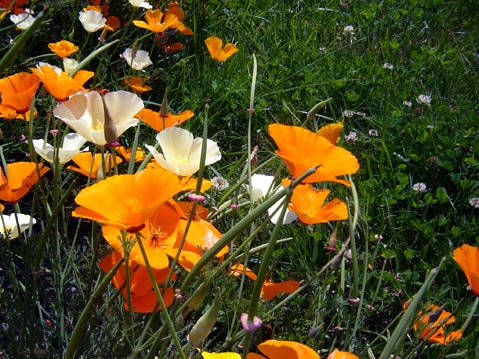Gardening: Poppies
The State Flower’s Glorious Bursts of Color

Springtime in California is heralded by a glorious burst of color as the state flower, the California poppy (Escholtzia californica), blooms in a continuous wave from south to north. Its popularity may stem from the fact that it grows in almost any soil type and climatic zone, including inland deserts, foggy coasts, and the high meadows of the Sierra. It is happy in a cow pasture or along a highway road cut — and it is extremely easy to grow in gardens, too.
This poppy is usually an annual — blooming, spreading seed, and dying in just a few months, although in areas with mild winters, it may persist as a perennial for several years. Its gray-green foliage forms a ferny rosette about eight to 12 inches tall topped by flower stalks that grow several inches higher. Each flower lasts just a few days, but the show continues as more are produced through several weeks or more. Once the first wave has passed, cut the whole plant down, and another surge will follow. There are some fabulous cultivated selections that range from palest ivory to lemon yellow, fire-engine red, and even lavender. Some varieties are crimped and crinkled; some are semi-double. Check the seed racks at area garden centers or online catalogs for the full array.
There is another spectacular native poppy. Speeding along the highway, the flowers look like sunny-side-up fried eggs. On closer inspection, they may seem like a fabrication of crepe paper and pipe cleaners. To touch, of course, the Matilija poppy (Romneya coulteri) is quite real. And up close, the fabulous, sweet fragrance will definitely enchant. These beguiling blossoms are enhancing the roadsides all over the county right now, sometimes in the least urbane of places. Road cuts, railroad rights-of-way, and other disturbed places are often colonized.
Starting seeds of this perennial is possible; some of the tips for success mention burning pine needles on top of the seed flat. It’s probably much easier to buy or propagate from already rooted shoots. Divisions of established plants should include well-rooted portions of the underground rhizomes. This can be tricky, so head into the middle of the clump for more mature portions in favor of the newer outer shoots. Nurseries also carry well-started plants. Once planted, as California natives, they don’t require summer water except in drought years. In the fall, cut all the foliage down close to the ground and wait for the new shoots to emerge after the first rains.
Other poppy relatives are available to add to the native garden. The bush poppy and island bush poppy (Dendromecon rigida and D. harfordii) grow as sturdy shrubs or small trees with grayish-green leaves. They sport two-inch, bright yellow flowers mostly in spring and early summer with a few popping out the rest of the year. Another useful shrubby poppy is the Mexican tulip poppy (Hunnemannia fumariifolia). Small, clear yellow poppy flowers top the blue-green foliage that grows only two to three feet high. Enjoy the state flower and its relatives while traveling this spring and maybe even include them in your landscape for patio viewing.



